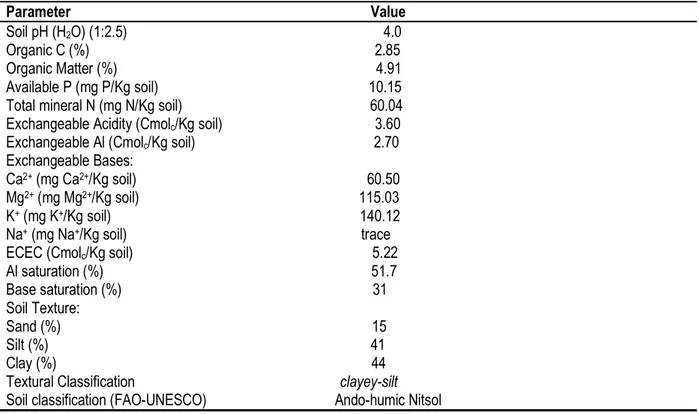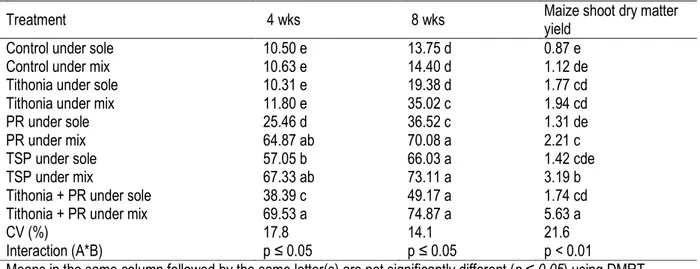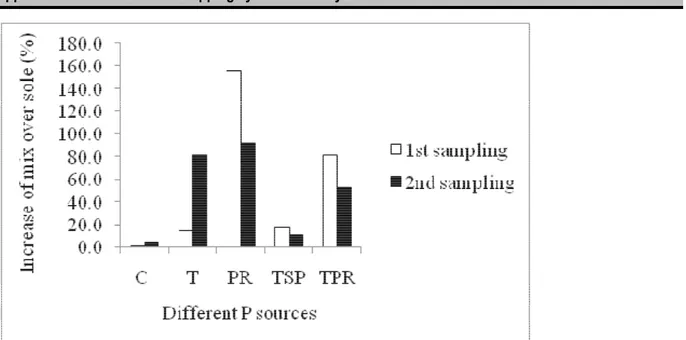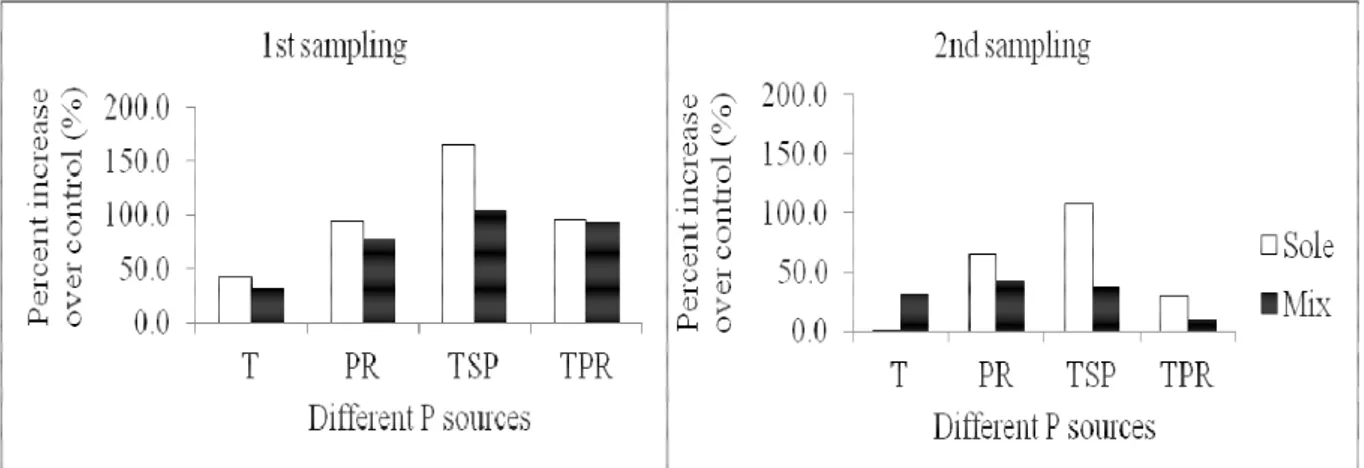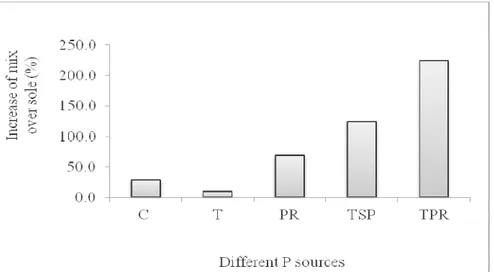6983
Maize response to Tithonia diversifolia and rock
phosphate application under two maize cropping
systems in Kenya
Filbert L. Ahmat1*; Jayne N. Mugwe2; Stephen K. Kimani3, and Joseph P. Gweyi-Onyango1
1Department of Agricultural Science and Technology, Kenyatta University, P.O Box 43844-00100 Nairobi, Kenya. 2Department of Agricultural Resources Management, Kenyatta University, P.O Box 43844-00100 Nairobi, Kenya. 3Kenya Agricultural Research Institute, P.O Box 57811 Nairobi, Kenya
*Corresponding author: filbertleone@gmail.com , Mobile: (+254) 712173466
Original submitted in on 7th July 2014. Published online at www.m.elewa.org on 31st July 2014.
http://dx.doi.org/10.4314/jab.v79i1.18 ABSTRACT
Objective: The experiment was conducted with the aim of investigating maize response to Tithonia diversifolia and Minjingu Rock phosphate (MPR) applied under maize-bean intercrop as compared to the traditional maize monocrop to improve maize grain yields.
Methodology: The experiment was conducted in pots in a greenhouse for the duration of 8 weeks.. The trial was laid out in a split plot arrangement with three replicates. The main plots comprised of sole maize crop and maize-bean intercrop whereas the sub plots included the control (no input), Tithonia biomass applied alone, MPR also applied alone, TSP again applied alone and Tithonia biomass co-applied with MPR. Soil samplings were done at 4 and 8 weeks after planting and assessed for .P availability and soil labile P. Data was also taken on maize dry matter yield at 8 weeks. ANOVA was done using SAS (version 9.2) and means separated at 5% probability level using DMRT.
Results: Maize-bean intercrop was effective in increasing PR solubilisation, P availability and shoot dry matter production. At the same level of P input from MPR, P availability under maize-bean intercrop increased above the ones under sole maize by 154.8% and 91.4% in the first and second samplings, respectively. The increase is thought to have been partly due to the effect of the rhizosphere acidification by bean (Phaseolus vulgaris) during the process of biologically nitrogen fixation.
Implications: This farmers-practices matching and also environmentally-friendly low input approach enables farmers to boost production, cut down the cost of production and consequently increase the profit margin. Key words: Maize-bean intercrop; Maize shoot dry matter yield; P availability; Rock phosphate solubility. INTRODUCTION
With the persistently widespread declining crop yields, there is great fear that one day the world will be in trouble as food production may not be enough to meet the demand of the fast growing human population which is projected to be 8,000 million by 2020 and 9,400 million by 2050 (Lal,
2000). Decline in crop yields is mainly caused by loss of soil fertility from nutrient deficiencies caused by factors such as erosions, nutrient imbalance and inherent soil property.
Phosphorus (P) is one of the critical elements that limit plant production, particularly in humid and sub
Journal of Applied Biosciences 79:6983 – 6991
6984 humid acid soils (Fairhurst et al., 1999). The situation is aggravated in smallholder agriculture where use of mineral fertilizers is limited or even inexistent, as peasant farmers, due to their low purchasing capacities, cannot afford high costs of these fertilizers (Jama and Van Straaten, 2006). Rock phosphate (PR) provides an alternative to the expensive soluble P. Unfortunately, use of Rock phosphate (PR) to alleviate P deficiency in the soils remains a great challenge due to their low solubility. PR is a water-insoluble but acid-soluble indigenous P source (FAO, 2004). On the other hand, use of organic material, which was however deemed to offer a better alternative to the problem, has reportedly been shown to be ineffective in increasing crop yields on P deficient soils
(Gachengo et al., 1999). The characteristically low P concentration of organics was underlined as the reason for their poor performance on these soils. PR is acid-soluble and activities that increase rhizosphere acidification increase its solubility. Nitrogen fixation is one such aspect that significantly lowers rhizosphere pH (Maschner, 1995). In the light of the proceeding, a greenhouse pot experiment was therefore conducted to investigate the effect of the acids secreted by bean (Phaseolus. vulgaris) into the rhizosphere (during the biologically nitrogen fixation process) on Minjingu PR solubility as well as the subsequent contribution to the plant available P fraction, and on P uptake by maize in a maize-bean intercrop system.
MATERIALS AND METHODS
Study Location: The study was conducted in the Kenya Agricultural Research Institute (KARI) center of Muguga South, located in Kiambu County, Kenya. The center is situated at an altitude of 2,100 MASL and on latitude 10 14’ south and longitude 360 38’ east. Muguga falls within the central highlands of Kenya.
Site Characterization: The soil used for the experiment was obtained from Kavutiri in Western Kenya, and was found to be extremely acidic, low in plant available P but generally high in organic C and in exchangeable aluminium, thus resulting into an aluminium saturation of above 50% (Table 1).
Table 1: Characteristics of soil obtained from Kavutiri
Parameter Value Soil pH (H2O) (1:2.5) 4.0
Organic C (%) 2.85 Organic Matter (%) 4.91 Available P (mg P/Kg soil) 10.15 Total mineral N (mg N/Kg soil) 60.04 Exchangeable Acidity (Cmolc/Kg soil) 3.60 Exchangeable Al (Cmolc/Kg soil) 2.70 Exchangeable Bases:
Ca2+ (mg Ca2+/Kg soil) 60.50 Mg2+ (mg Mg2+/Kg soil) 115.03 K+ (mg K+/Kg soil) 140.12 Na+ (mg Na+/Kg soil) trace ECEC (Cmolc/Kg soil) 5.22
Al saturation (%) 51.7 Base saturation (%) 31 Soil Texture: Sand (%) 15 Silt (%) 41 Clay (%) 44 Textural Classification clayey-silt
6985 Design, Treatments and Samplings: The greenhouse pot experiment was organized in a split plot design with two factors. Factor A, the cropping system had two sub-factors i.e. maize monocrop and maize-bean intercrop; while factor B (P input) was composed of five sub-factors; control (zero input); sole Tithonia applied at the corresponding field rate of 10 Kg P/ha; Rock Phosphate (PR) at 60 Kg P/ha; Triple Super Phosphate (TSP) at 60 Kg P/ha, and Tithonia and PR (TPR) combined at 10 and 50 Kg P/ha, respectively.. Each treatment was replicated three times. Crops used in the experiment were maize, H 614 D considered the main test crop, and bean,) which was specifically involved in the experiment for its acidifying role on soil. Maize (Zea mays) variety H 614 D and bean (Phaseolus vulgaris) variety GLP-X 1127 A were used in the trial. The experiment was planted in 5L-capacity polythene pots filled with 4.5 Kg of P deficient acid soil collected from Kavutiri. After P inputs application, the soil was wetted to 60% of the field capacity after which the gross weight of every pot was immediately recorded for future reference while re-adjusting the moisture of the soil to the initial level (60% of the field capacity). Weight adjustments were done every three days. Seeds were sown seven days after initiation of the experiment. Maize was thinned at the height of 10 cm to one plant per pot in intercrop and three plants per pot in monocrop. After two weeks, Beans in their turn were thinned to two per pot. Sampling of soils for laboratory analyses was done twice, at 4 and finally at 8 weeks after planting. The sampling was done at the depth of 8 – 10 cm using a stainless steel tablespoon. The experiment was concluded at the last sampling during which maize (including beans) was harvested and oven-dried at 65 0C to constant weight and dry matter production was assessed.
Laboratory Analyses: Soil pH was determined in water (1:2.5 soil: water ratio) with a pH-meter according
to the method of McLean (1965). Exchangeable acidity and Al were extracted by 1M KCl solution and determined titrimetrically (McLean, 1965). Exchangeable bases (Ca2+, Mg2+, K+ and Na+) were extracted by 1M NH4OAC (ammonium-acetate) solution and determined by an atomic absorption adjusted at specific wavelengths (422.7 nm for Ca2+; 285.2 for Mg2+; 766.5 nm for K+; and 585.2 for Na+), as described by Okalebo et al. (2002). In regard to P pools, soils were extracted for labile P (weakly adsorbed P) by 0.5M NaCO3solution with the pH adjusted to 8.5; and for plant available P by a mixture solution of 0.03N NH4F and 0.1N HCl. In both extracts P determination was done colorimetrically using a (UNICAM 8625 UV/VIS) spectrometer pre-set to 882 nm wavelength (Okalebo et al., 2002). Soils for mineral nitrogen (NO3 -N and -NH4-N) were extracted by 2M KCl solution and determined using a ‘Segmented Flow Analyzer’ in accordance with the laboratory method; and the total mineral nitrogen (N) of a sample was calculated as the sum of the two fractions of mineral N. Walkley and Black (1934) method was used to determine soil organic carbon whereas Soil Organic Matter (SOM) was calculated according to the method of Anderson and Ingram (1993). As far as the determination of total N, P and K in plant tissue was concerned, tissue samples were extracted by wet digestion and total N and K in the digest were measured by absorbency (Atomic Absorption Spectrometer) and total P determined colorimetrically using a Spectrometer. Statistical analysis : Analysis of variance was conducted using the general linear model procedure of the Statistical Analyses Software (SAS) program (SAS Institute, version 9.2). Mean separation was done at 5% probability level using new Duncan’s Multiple Range Test (DMRT).
RESULTS AND DISCUSSION
Plant Available P in the Soil: The research revealed that effects of Tithonia diversifolia and Rock Phosphate on P availability resulting from P-inputs when applied under mix systems did not significantly differ from those achieved under sole maize treatment. Those inputs included in this category were T, TSP and the controls in the first sampling, and TSP, TPR and the controls in the second sampling. However, PR and TPR in the first sampling and T and PR in the second
sampling (Table 2) showed significant differences based on available P when the two systems were compared. Only PR under the two systems in place consistently resulted to significant yield differences during the two samplings. Increases obtained under mix system in relation to sole system for this input (PR) were 154.8% and 91.9% during the first and second samplings, respectively. A considerable drop in the percent increase was noted at the second sampling.
6986
Table 2: Treatment effect on plant available P (mg P/Kg soil) at 4 weeks and 8 weeks, and maize shoot dry matter yield at 8 weeks.
Treatment 4 wks 8 wks Maize shoot dry matter
yield
Control under sole 10.50 e 13.75 d 0.87 e
Control under mix 10.63 e 14.40 d 1.12 de
Tithonia under sole 10.31 e 19.38 d 1.77 cd
Tithonia under mix 11.80 e 35.02 c 1.94 cd
PR under sole 25.46 d 36.52 c 1.31 de
PR under mix 64.87 ab 70.08 a 2.21 c
TSP under sole 57.05 b 66.03 a 1.42 cde
TSP under mix 67.33 ab 73.11 a 3.19 b
Tithonia + PR under sole 38.39 c 49.17 a 1.74 cd
Tithonia + PR under mix 69.53 a 74.87 a 5.63 a
CV (%) 17.8 14.1 21.6
Interaction (A*B) p ≤ 0.05 p ≤ 0.05 p < 0.01
Means in the same column followed by the same letter(s) are not significantly different (p ≤ 0.05) using DMRT. The significant variations (increases) in the
concentration of available P that occurred mainly in PR- or PR-related soil treatment under mix system as compared to what was observed under sole system might have been likely brought about by the effects of acids released into the rhizosphere of beans on PR solubility (Troelstra et al., 1985; Dakora and Phillips, 2002; Sugiyama and Yazaki, 2012). This was apparently confirmed by the slight change noticed in the trend of available P in TPR during the second sampling, where differences contributed by TPR under the two systems was insignificant as opposed to the first sampling. The second sampling was done at an advanced developmental stage, when the bean crop was closer to maturity and apparently had minimal N2 fixation. In an overall perspective, the significantly highest available P concentrations were obtained in PR, TSP and TPR under mixed system in the first sampling and only in TSP and TPR under both mix and sole systems during the second sampling. Evidently, maturation of the bean crop could be the reason for the disappearance of differences of the concentrations of available P recorded under the two systems during the
second sampling. In a physiologically view point, maturation of bean plants led to a decline in the activities of the biologically nitrogen fixation and the consequent diminished release of acids into the rhizosphere (ACIAR, 2008). The lowest significant concentrations of available P were obtained in T (Tithonia diversifolia )and controls under both mix and sole systems in the first sampling whereas in the second sampling T under mix system was significantly above T under sole system and all the controls under both sole and mix systems. This suggested that the acids secreted by beans into the rhizosphere (Sas et al., 2001; Teng et al., 2004; Cheng et al., 2004) could in no way contribute significantly to a rise in the available P concentrations in the absence of a considerable amount of calcium-bound P (Ca-P) in the soils (figure 1). Undoubtedly, this provided an obvious explanation as why there was a significant difference in available P concentrations in T-amended soils under the two systems only in the second sampling (but not in the first sampling).
6987
Figure 1: Percent increase of plant available P under mix system above the one under sole system achieved from the same P input source applied at an equal rate.
The first sampling was done when the mineralization of P resulting from the decomposition of Tithonia leafy biomass was deemed incomplete (Gachengo et al., 1999; Partey et al., 2011). Thus, Tithonia was deemed to have contributed a lesser amount of mineral P to the existing soil available P pool, which was by then mainly reinforced by P resulting from the dissolution of soil inherent Ca-P minerals by the bean-root secreted acids. This concurred well with the finding of previous workers (Marschner et al. 1986; Perez et al. 2007; Wang et al. 2012 and Rubio et al. 2012). Between the sub-factor settings (sole and intercropping) of the main factor or factor (A) – cropping systems, some important increases were remarkable in plant available P in soils treated with the different P input sources under mix system as compared to sole. The percent increase, which ranged from 1.2 to 154.8% in the first sampling and from 4.7 to 91.9% in the second sampling, revealed how effective intercropping system was in enhancing P availability from the different P input sources utilized and how time influenced the effectiveness. The yield of the higher extreme values by only PR in both samplings suggested that the bean
through its root-secreted acids into the rhizosphere was much effective in increasing P availability from PR than from any of the P input sources applied.
Labile P in the Soil: Unlike the first sampling in which PR, TSP and TPR under intercropping system together with TSP under sole system yielded the highest significant amounts of labile P, the second sampling was characterized by a significant decline in the amounts of the P that occurred in PR, TSP and TPR under intercropping system (Table 3). The second sampling was done when the beans were almost reaching the end of the pods formation stage, which was the stage during which the plant physiological functions, including the biologically nitrogen fixation on which depended the synthesis and release of the bean-produced acids (H+), were assumed to have intensified and gotten to the peak (ACIAR, 2008). Achieving a decline in the level of labile P under bean- integrated system at this particular moment could lead to the speculation that the bean-produced acids, which now had been massively released into the soil, might have been the cause.
6988
Table 3: Treatment effect on the soil labile P fraction (mg P/Kg soil) at 4 weeks and 8 weeks, and maize shoot dry matter yield at 8 weeks.
Treatment 4 wks 8 wks Maize shoot dry
matter yield
Control under sole 10.50 e 15.64 d 0.87 e
Control under mix 14.04 de 17.13 d 1.12 de
Tithonia under sole 14.99 cde 15.84 d 1.77 cd
Tithonia under mix 18.51 cd 22.40 bc 1.94 cd
PR under sole 20.44 bc 25.90 b 1.31 de
PR under mix 24.94 ab 24.40 bc 2.21 c
TSP under sole 27.84 a 32.51 a 1.42 cde
TSP under mix 28.63 a 23.39 bc 3.19 b
Tithonia + PR under sole 20.49 bc 20.35 cd 1.74 cd
Tithonia + PR under mix 27.12 a 18.80 d 5.63 a
CV (%) 15.4 13.1 21.6
Interaction (A*B) p ≤ 0.05 p < 0.01 p < 0.01
Means in the same column followed by the same letter(s) are not significantly different (p ≤ 0.05) using DMRT. The decline in labile P noted during the second
sampling in the soils to which were added the three different P sources (PR, TSP and TPR) under intercropping system was inversely coupled with a significant rise in the amounts of plant available P achieved in the soils during that same moment. From this result it was presumable that the bean-produced acids contributed to the enhancement of plant available P fraction in the soil through raising the level of PR solubility in a PR-amended soil; dissolving part of the soil inherent calcium-bound P (Ca-P) minerals stock; and promoting desorption of labile P. Having T and TPR at the same lowest level of significance with the controls was an indication of lesser P fixation occurrence in the soils. This was attributed to the multiple roles played by the organic acids, product of
the decomposition of Tithonia leafy biomass (Ikerra et al., 2011). The organic acids were said to hinder P sorption and promote desorption of the weakly fixed P (labile P) in the soil. This was perceived as an added advantage to the role played in the system by the bean-root produced acids. Trends observed under the two systems were but only similar during the first sampling (Figure 2). In the experiment, a substantial amount of P was fixed in TSP under both sole and mix systems as indicated by the highest percent increase. Achieving relatively lower percent increase of labile P over the control, which was perceived as an indication of lower P fixations from the inputs applied, under intercropping system thus revealed the P sorption-hindering role played by bean in the system.
6989 Maize Shoot Dry Matter Yield: A number of discrepancies was noticed in regard to the performances of the different P inputs used when the performance of shoot dry matter yields was compared to that of plant available P in the soil. The performance trend of the shoot dry matter yield in maize did not consistently concur with the one of plant available P in either of the samplings. In relation to plant available P results for the two samplings, TPR together with PR under sole system were always classified the second highest in significance after TSP while PR, TSP and TPR under mix system performed at the same highest level of significance (table 2). In the light of all these, obtaining the highest significant shoot dry matter yield in TPR, TSP and T under sole system and only in TPR under mix system implied that P deficiency might not be the only limiting factor to crop production in this soil used for the trial. For instance, the soil very high aluminium saturation (Table 1) might have been another factor, which would invariably affect crop production. Such observation resonated quite well with the finding of ‘Fertilizer Use Recommendation Project’ –
FURP (1994) which reported a high saturation of 40 - 50% of phyto-toxic (monomeric) spices of aluminium (Al3+) in the area (Kavutiri) from where the soil used for this experiment was collected. Al3+ was said to be as detrimental to crop production in that soil and this is again tied to the known P deficiency in such soil. Presumably, this might have been the reason which underlay the good performance of T when applied alone or in association with PR in the soil as, this in addition to P contribution may reduce aluminium toxicity by production of carboxylates (Tithonia) and slight alkalinisation of rhizosphere pH. Ikerra et al. (2006 and 2011) reported that the organic compound, product of the decomposition of Tithonia leafy biomass, was effective in reducing the concentration of Al3+ in the soil by complexion of Al molecules to form an organo-Al complex. In a way, this could partly explain why Tithonia, which did not have significant production of plant available P in the soil after decomposition, emerge as one of the best-input sources for the achievement of an improved maize shoot dry matter yield.
Figure 3: Percent increase of maize shoot biomass yield in mix system over the one in sole system obtained from the same P input source applied at an equal rate.
Secondly, when comparing the highest significant amounts of maize shoot dry matter per plant, which was simply referred to as the dry matter yield, in the two systems studied, there was a very big difference. The highest dry matter production was obtained in TPR and TSP under sole system and only in TPR under mix
system. However, the amount of dry matter in TPR under mix system was slightly above three-folds and nearly four-folds the amount got under sole system in TSP and TPR, respectively. This could tell how much the beans intercropped with maize benefited the maize in addition to the P inputs applied (Cu et al., 2005).
6990 CONCLUSION
The advantage of the intercrop of maize with bean was revealed to be far beyond: a mere diversification of harvests in time and in space; an effective utilization of cultivated land and labour; and a precautious measure in case of crop failure of, or compensation of poor yield from one crop. When Tithonia leafy biomass in combination with PR source is used under maize-bean intercrop on a P deficient acid soil, it not only performs better than TSP fertilizer but also it improves the structure and texture of the soil and suppresses soil
acidification hazard. Soil acidification is a general but undesirable characteristic of mineral fertilizers, which imminently takes place when used on a farmland for prolonged time. This advantage and much more of the utilization of these locally available low input sources to improve crop yields on P deficient soils adds up to their ease acquisition by the financially-constrained peasant farmers mainly found in the Sub-Sahara Africa and for whom access to agricultural credits is very limited.
ACKNOWLEDGEMENT
We would like to thank the Catholic Diocese of Tombura-Yambio in South Sudan, in particular His Lordship, Bishop Edward Hiiboro Kussala for funding the research study in addition to his moral motivation. We are also much grateful to the Senior Laboratory Technologist , Head of Chemistry Division Laboratory;
and all the other staff members of the Chemistry Division of Kenya Agricultural Research Institute (KARI) center of Muguga South for conducting the sample analyses, for their technical advice and close collaboration..
REFERENCES
ACIAR, 2008. Measuring Plant-association Nitrogen Fixation in Agricultural Systems. Australian Center for International Agricultural Research (ACIAR).
Anderson JM, Ingram JSI, 1993. Tropical Soil Biology and Fertility: A Handbook of Methods (2nd Ed.). CAB International, Wallingford, UK. Cheng Y, Howieson JG, O’Hara GW, Watkin ELJ,
Souche G, Jaillard B, Hinsinger P, 2004. Proton Release by Roots of Medicago murex and Medicago sativa Growing in Acidic Conditions, and Implication for Rhizosphere pH Changes and Nodulation at Low pH. Soil Biology and Biochemistry 36: 1357–1365. Cu ST, Hutson J, Schuller KA, 2005. Mixed Culture of
Wheat (Triticum aestivum L.) with White Lapin (Lapinus albus L.) Improves the Growth and Phosphorus Nutrition of the Wheat. Plant and Soil 272: 143-151.
Dakora FD, Phillips DA, 2002. Root exudates as Mediators of Mineral Acquisition in Low-nutrient Environments. Plant and Soil 245: 35 – 47.
Fairhurst T, Lefroy R, Mutert E, Batjes N, 1999. The importance, Distribution and Causes of Phosphorus Deficiency as a Constraint to Crop Production in the Tropics. Agroforest Forum, 9:2-8.
FAO (2004): Use of Phosphate Rocks for Sustainable Agriculture. FAO fertilizer and plant nutrition bulletin 13; Rome, Italy.
Fertilizer Use Recommendation Project, 1994. Kenya Agricultural Research Institute (KARI), Nairobi, Kenya.
Gachengo CN, Palm CA, Jama B, Othieno C, 1999. Tithonia and Senna Green Manures and Inorganic Fertilizers as Phosphorus Sources for Maize in Western Kenya. Agroforestry Systems 44: 21 – 36.
Ikerra ST, Semu E, Mrema JP, 2006. Combining Tithonia diversifolia and Minjingu Phosphate Rock for Improvement of P Availability and Maize Grain Yield on a Chromic Acrisol in Morogoro, Tanzania. Nutrient Cycling in Agroecosystems 76:249 – 260.
Ikerra ST, Semu E, Mrema JP, 2011. The Secret Behind the Good Performance of Tithonia diversifolia on P Availability as Compared to Other Green Manures. Springer Science + Business Madia B.V.
Jama, B. and Van Straaten, P. (2006): Potential of East African Phosphate Rock Deposits in Integrated Nutrient Management Strategies. Anais da acadamia Brasileira Ciencias 78 (4):781-790.
Lal, R. (2000): Soil Management in the Developing Countries. Soil Science 165 (1): 57-72.
6991 Marschner H, 1995. Mineral Nutrition of Higher Plants.
2nd edn. Academic Press, London, UK 889pp. Marschner H, Romheld V, Horst WJ, Martin P, 1986. Root-induced Changes in the Rhizosphere: Importance for the Mineral Nutrition of Plants. Z. Planzenernaehr. Bodenk. 149: 441 – 456. Okalebo JR, Gathua KW, Woomer PL, 2002.
Laboratory Methods of Soil and Plant Analyses: A Working Manual (2nd Ed.). Nairobi, Kenya.
Partey ST, Quashien-Sam SJ, Thevathasan NV, Gordon AM, 2010. Decomposition and Nutrient Release Patterns of the Leafy Biomass of the Wild Sunflower (Tithonia diversifolia): a Comparative Study with Four Leguminous Agroforestry Spices. Agroforestry Systems 81: 123-134.
Perez MJ, Smyth TJ, Israel DW, 2007. Comparative Effects of Two Forage Species on Rhizosphere Acidification and Solubilization of Phosphate Rocks of Different Reactivity. Journal of Plant Nutrition 30: 1421 – 1439. Rubio G, Faggioli V, Scheiner JD, Gutierrez-Boem FH,
2012. Rhizosphere Phosphorus Depletion by Three Crops Differing in their Phosphorus Critical Levels. Journal of Plant Nutrition and Soil Science 175:810 – 817.
SAS Institute Inc. 2008. SAS/STAT ® 9.2 User’s Guide. Cary, NC: SAS Institute Inc.
Sas L, Rengel Z, Tang C, 2001. Excess Cation Uptake, and Extrusion of Protons and Organic Acid Anions by Lapinus albus under Phosphorus Deficiency. Plant Science 160: 1191 – 1198. Sugiyama A, Yazaki K, 2012. Root Exudates of
Legume Plants and their Involvement in Interactions with Soil Microbes. Springer – Verlag Berlin Heidelberg.
Tang C, (Symposium No. 43, Scientific Reg. No. 1681). Soil Acidification under Legumes – an Australian Viewpoint.
Tang C, Drevon JJ, Jaillard B, Souche G, Hinsinger P, 2004. Proton Release of Two Genotypes of Beans (P. vulgaris L.) as Affected by N Nutrition and P Deficiency. Plant and Soil 260: 59 – 68.
Troelstra SR, Van Dijk K, Blacquiere T, 1985. Effects of N source on Proton Excretion, Ionic Balance and Growth of Alnus glutinosa (L) Gaertner: Comparison of N2 Fixation with Single and
Mixed Sources of NO3 and NH4. Plant and Soil 84: 361 – 385.
USDA - United States Department of Agriculture - 2010. Plant Profile. Tithonia diversifolia
(Hemsl). A. Gray.
http://plants.usda.gov/java/profile?symbol=TID I2
Walkley A, Black IA, 1934. An examination of the Degtjareff Method for Determining Soil Organic Matter, and a Proposed Modification of the Chromic Soil Titration Method. Soil Science 37, a-38.
Wang Y, Marschner P, Zhang F, 2012. Phosphorus Pools and other Soil Properties in the Rhizosphere of Wheat and Legumes Growing in Three Soils in Monoculture or a Mixture of Wheat and Legume. Plant Soil 354: 283-298.
